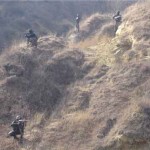26/11. The terrorists held sway and centrestage for four days as they basked in an electronic media blitzkreig. Another day, another time, this time in Poonch, the terrorists took on the might of the Indian Army and severely dented its image.
If Mumbai, the concrete jungle had no parallels for its sheer planning, novelty, precision and brutality of attacks, Poonch, the jungle terrain, the scene of another stand off too has no parallels in terms of longevity and boldness. If in Mumbai, the elite NSG commandos took time in neutralising the terrorists to avoid collateral damage and civilian casualties, the Poonch ‘citadel’ is purported to have been affected by the terrain and weather conditions! Be as it may, the terrorists are giving the security forces a run for their money and surely gaining at the altar of oxygen of publicity — the prime objective of all terror attacks.
Indian Army, veterans of counter-insurgency operations all over since its inception, to be suddenly so held at bay by a handful of militants in a small locality in Jammu and Kashmir, and perhaps in one of the most densely militarised zones in the world, is a matter of concern.
In the aftermath of the Mumbai attacks, the attention of the Indian media was quickly drawn to the raging gun battle in Poonch when on the New Year’s day, news trickled in of the Army’s engagement with a group of terrorists inside Bhati Dhar forest in Mendhar where it suffered two casualties.
In the recent past, the Army has shown a cautious approach to such situations like the Chinore hostage crisis in Jammu in August 2008, where operations were rightly deliberate to prevent colateral damage and to avoid hostage deaths, although at the end of the day long siege some hostages were killed by the three ‘fidayeen’ terrorists and in Mumbai the terrorists had inflicted casualties in the hundreds even before the NSG was sent in. To still have persisted with the siege only provided added mileage to the terrorists and their creed worldwide.
Civilian casualty and urban area imperatives notwithstanding, the Army in the case of the recently concluded marathon operation in Poonch was left quite out-flanked with no ‘colateral damage, civilian casualties’ cliches to offer. After all the handful of militants were holed up in a remote forest hideout with no civilian habitat in the firing line! So it hurriedly offered the ‘avoiding own casualty’ line and harked on the difficuties caused by fog, undulating terrain, rocks, etc. And, at the end of it all, the terrorists had once again slipped away! For the fourth largest Army in the world, and the victors of several wars, and veterans of counter-insurgency operations all over since its inception, to be suddenly so held at bay by a handful of militants in a small locality in Jammu and Kashmir, and perhaps in one of the most densely militarised zones in the world, is a matter of concern.
Background
The terrain — pine forests with natural caves, etc will definitely impinge on flushing out operations, but allowing these constraints to so retard the operations for more than eight days is not something one has come to expect from the battle hardened Indian Army. After all it has operated in even thicker and much tougher jungles in the Northeast. In Jammu and Kashmir, the visibility in the forests pine is much better than sun in the tropical jungles of the Northeast. There is even lesser undergrowth.
If, even after breaking the back of militancy and depleted militant strength in J&K, militants have managed to carve hideouts just behind the two tiers of Army deployment, something has definitely gone awry somewhere.
Critically the, Mendhar has been a traditional militant hot bed since 1995-96, due to its close proximity to the LoC. The linear pattern of Army deployment, forested mountain slopes and ravines of the Surankot bowl provide an easy access routes to Doda in the east and the valley of Kashmir in the north. Undulating terrain and many forested spurs opening into POK, the unfavourable delineation of the LoC facilitated infiltration, and lack of surface links and security force deployment in the hinterland provided safe havens to the militants. Post Kargil, the erstwhile transient types were joined by a large number of foreign militants and some of the major massacres of minority commmunity and attacks on security forces took place in the Rajouri and Poonch districts. This led to the creation of Counter-Insurgency Force ‘Romeo’ for the hinterland, and by 2006 the situation was brought largely under control, and the Army claimed to have restored ‘near normalcy’ in the region. This period coincided with the ceasefire along the LoC and the construction of the fence to effectively check infiltration. The field commanders now decided to shift focus on the LoC the emphasis being on ‘preventing infiltartion at all costs’.
True, infiltartion and levels of violence in the hinterland has reduced considerably, but the terror forces are adept at quick change in tactics and improvisations, in contrast to our more orthodox and deliberate tactics.
Sequence of Events Leading to Bhati Dhar Stand Off
If, even after breaking the back of militancy and depleted militant strength in J&K, militants have managed to carve hideouts just behind the two tiers of Army deployment, something has definitely gone awry somewhere.
In the closing months of 2008, in a short radius of about 10 kilometres between Krishna Ghati and Mendhar, a group of militants had managed to escape the Army dragnet on at least three occasions, starting on September 27, 2008 when three LeT militants escaped from a house in Chhajla village near Mendhar when a joint party of 39 RR and 7 Kumaon swooped upon them. Then, on polling day in Poonch (November 17) ,5 Assam lost one jawan and two sustained injuries when militants fired upon a search party in Beri Rakh forest not too far away from the site of the previous encounter in Chhajla. This group was once again surrounded on November 20 by 7 Kumaon where miraculously they again managed to give the SF a slip! On October 14, 2008 two LeT militants were killed slightly northwards in Sangiot in Kalaban by 38 RR. A few war like stores were recovered from Jugal Top and Tain in October and November.
Even after sending in its Special Forces and maintaining a cordon for nine days, the militants managed to flee…
Though, it is not certain whether these militants belonged to the same group holed up in Bhati Dhar, it should have been clear that something was wrong and the militants were having back-up nearby, where they were recoiling after giving the Army a slip on several occasions. So, it may well be possible, that this time too in Bhati Dhar the bulk of the militants broke the Army cordon in the first two days itself, pouncing heavily on one part of it, leaving behind a couple of them to hold the Army back. They are then believed to have disguised as nomad bakkervals and melted away.
Even after sending in its Special Forces and maintaining a cordon for nine days, the militants managed to flee shows that after the encounter on the first day, the Army never had close contact with them and were not even certain on the number of militants holed up there. This is also reinforced by the fact that it took them a while to retrieve the body of the JCO as the volume of militant fire was probably very prohibitive and forced the Army back. A similar thing had happened in Beri Rakh forest on Nov 17.
Discovery of large quantities of ration and ammunition and their ability to fortify natural caves with CGI sheets points to a longer presence which is also borne out by their staying power and presence of some top commanders of LeT and JeM. There were also erstwhile Army bunkers in the area constructed during the pre-ceasefire days for safety against enemy shelling which may have been used by the militants.





